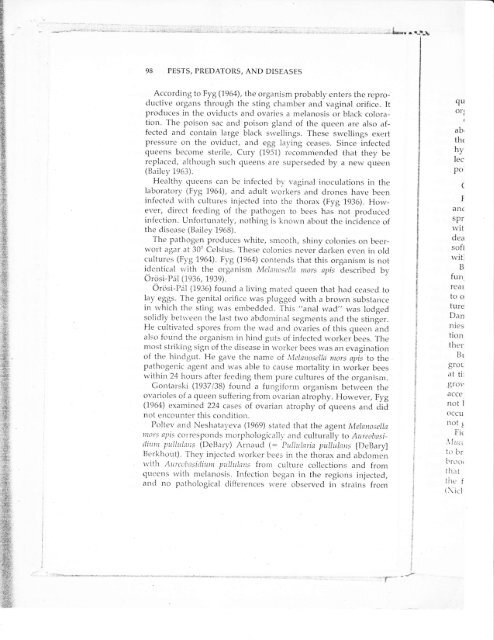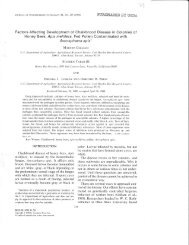Chalkbrood - Status Today and Hopes for Control' - Golden Rule Honey
Chalkbrood - Status Today and Hopes for Control' - Golden Rule Honey
Chalkbrood - Status Today and Hopes for Control' - Golden Rule Honey
You also want an ePaper? Increase the reach of your titles
YUMPU automatically turns print PDFs into web optimized ePapers that Google loves.
PISTS, PREDATORS, AND DISEASES<br />
According to Fyg (1961\, the organism probabll' errters the re.productive<br />
organs through the sting chamber <strong>and</strong> vaginal orifice. It<br />
produces in the oviducts <strong>and</strong> ovaries a melanosis or black coloration.<br />
J'he poison sac ancl poison.gl<strong>and</strong> of the queen are also affected<br />
<strong>and</strong> contain large black srvellings. These sn'ellings exert<br />
pressure on the oviduct, <strong>and</strong> egg laving ceases. Since infected<br />
queens become sterile, Ctrry. (1951) recomnrended that tl-rey be<br />
replaced, althougl'r such queens are superseded by a nerv queen<br />
(Bailcy'1963).<br />
Healthy r-luc.ens can tre infected bv vagirral inoculations in the<br />
laboratory (Fyg,796q, <strong>and</strong> adult rvorkers <strong>and</strong> drones have been<br />
infected n,ith cultures injected into the thorax (Fy'g 1936). However,<br />
direct feeding of the pathogen to be.es has uot produce.d<br />
infection. Un<strong>for</strong>tunatelv, nothing is kno'rvn about ihe incidence of<br />
the disease (Bailey 7968).<br />
The pathogen Frroduces lvhite., smooth, sl'riny colc,rnies on beerlvort<br />
agar at 30' Celsius. These colonies never darken even in old<br />
cultures (F1'g 196a). Fvg (i964) contends tl-rat this organism is not<br />
idcntical rrith the org;.rnism Mclunscllrt nrors npis described by<br />
Orosi-P6l (1936, 1,939).<br />
Orcjsi-Pal (1936) found a livir-rg matecl queen that had ceascrl to<br />
Iav eggs. The genital orifice was plugged rvith a brown substance<br />
in n'hich the sting n'as embeddecl. This "anal rvacl" rvas lodged<br />
soliclll'betn'een the last tr.vo abdominal segments aird the stirrger.<br />
He cultivated spores from the 'rvad <strong>and</strong> or.aries of this queerr a'cl<br />
also fourrd tl-re organisnr in hind guts of infected worker bee.s. T'he<br />
n'rost strikir-rg sign of the disease in rvorker bees was an evagination<br />
of the hiridgut. He gave the name of Melnnosella nrttrs npis to the<br />
pathogenic agent <strong>and</strong> n'as able to cause mortality in worker bees<br />
within 24 hours after feeding them pr-rre culturts of the organism.<br />
Corrtarski (7937138) found a fungi<strong>for</strong>m organism betrveen the<br />
ovarioles of a queen suffering from ovarian atrophy. I{orvever, Fyg<br />
(1964) examined 224 cases of ovarian atroplrl' of queens ancl clid<br />
not encounter this condition.<br />
Polte' <strong>and</strong> Neshatave'a (1969) stated that the agent Meranoseiln<br />
urLlrs opis corresponds morpl-rologicallv <strong>and</strong> culturally to AurettltnsidiLtrtt<br />
pullultris (Del3aly) Arnaud \: Pullulnrin Ttullularrs [DeBary]<br />
Llerkl-rout). They' injccted 'r'orker bees in the thorax <strong>and</strong> abclome.n<br />
rr'ith Arrrcirbttsitihrm Ttullulans fronr cultule collectiorrs <strong>and</strong> from<br />
qucens nitir nrelanosis. Infection began in the regions injected;<br />
<strong>and</strong> no pathological differences \\'ere observed i. strains from<br />
:.;!:&nt r<br />
'{-<br />
qu<br />
ol'i<br />
I<br />
ab,<br />
th(<br />
h1,<br />
lec<br />
Po<br />
(<br />
T<br />
an(<br />
spr<br />
u'it<br />
dea<br />
soft<br />
rvit,<br />
B<br />
fun,<br />
r€-aI<br />
too<br />
ture<br />
Dan<br />
nies<br />
tion<br />
ther<br />
Br<br />
gror<br />
at tir<br />
gro\.<br />
acce<br />
not I<br />
occu<br />
not 1<br />
Fie<br />
.\ I uct<br />
ttr br<br />
broo,<br />
tha t<br />
tirc f<br />
(\icl



